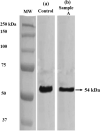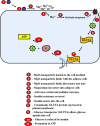Cytotoxicity and insulin resistance reversal ability of biofunctional phytosynthesized MgO nanoparticles
- PMID: 33123456
- PMCID: PMC7588583
- DOI: 10.1007/s13205-020-02480-2
Cytotoxicity and insulin resistance reversal ability of biofunctional phytosynthesized MgO nanoparticles
Abstract
The present study investigates the cytotoxicity of hexagonal MgO nanoparticles synthesized via Amaranthus tricolor leaf extract and spherical MgO nanoparticles synthesized via Amaranthus blitum and Andrographis paniculata leaf extracts. In vitro cytotoxicity analysis showed that the hexagonal MgO nanoparticles synthesized from A. tricolor extract demonstrated the least toxicity to both diabetic and non-diabetic cells at 600 μl/ml dosage. The viability of the diabetic cells (3T3-L1) after incubation with varying dosages of MgO nanoparticles was observed to be 55.3%. The viability of normal VERO cells was 86.6% and this stabilized to about 75% even after exposure to MgO nanoparticles dosage of up to 1000 μl/ml. Colorimetric glucose assay revealed that the A. tricolor extract synthesized MgO nanoparticles resulted in ~ 28% insulin resistance reversal. A reduction in the expression of GLUT4 protein at 54 KDa after MgO nanopaSrticles incubation with diabetic cells was observed via western blot analysis to confirm insulin reversal ability. Fluorescence microscopic analysis with propidium iodide and acridine orange dyes showed the release of reactive oxygen species as a possible mechanism of the cytotoxic effect of MgO nanoparticles. It was inferred that the synergistic effect of the phytochemicals and MgO nanoparticles played a significant role in delivering enhanced insulin resistance reversal capability in adipose cells.
Keywords: Adipose cells; Diabetes; Insulin resistance; MgO nanoparticles; Phytosynthesis.
© King Abdulaziz City for Science and Technology 2020.
Conflict of interest statement
Conflict of interestThe authors declare that they have no conflict of interest.
Figures









Similar articles
-
Cytotoxicity Analysis of Morphologically Different Sol-Gel-Synthesized MgO Nanoparticles and Their In Vitro Insulin Resistance Reversal Ability in Adipose cells.Appl Biochem Biotechnol. 2020 Apr;190(4):1385-1410. doi: 10.1007/s12010-019-03166-z. Epub 2019 Nov 27. Appl Biochem Biotechnol. 2020. PMID: 31776944
-
Photo-irradiation coupled biosynthesis of magnesium oxide nanoparticles for antibacterial application.Naunyn Schmiedebergs Arch Pharmacol. 2020 Dec;393(12):2253-2264. doi: 10.1007/s00210-020-01934-x. Epub 2020 Jul 7. Naunyn Schmiedebergs Arch Pharmacol. 2020. PMID: 32632566
-
Blockage of both the extrinsic and intrinsic pathways of diazinon-induced apoptosis in PaTu cells by magnesium oxide and selenium nanoparticles.Int J Nanomedicine. 2016 Nov 22;11:6239-6250. doi: 10.2147/IJN.S119680. eCollection 2016. Int J Nanomedicine. 2016. PMID: 27920530 Free PMC article.
-
Psoralea corylifolia L. Seed Extract Attenuates Methylglyoxal-Induced Insulin Resistance by Inhibition of Advanced Glycation End Product Formation.Oxid Med Cell Longev. 2019 Dec 26;2019:4310319. doi: 10.1155/2019/4310319. eCollection 2019. Oxid Med Cell Longev. 2019. PMID: 31976027 Free PMC article.
-
Phytosynthesized nanoparticles as a potential cancer therapeutic agent.3 Biotech. 2020 Dec;10(12):535. doi: 10.1007/s13205-020-02516-7. Epub 2020 Nov 16. 3 Biotech. 2020. PMID: 33224704 Free PMC article. Review.
Cited by
-
Sol-gel synthesis of magnesium oxide nanoparticles and their evaluation as a therapeutic agent for the treatment of osteoarthritis.Nanomedicine (Lond). 2024;19(23):1867-1878. doi: 10.1080/17435889.2024.2382421. Epub 2024 Aug 7. Nanomedicine (Lond). 2024. PMID: 39109508 Free PMC article.
-
MgO@SiO2 nanocapsules: a controlled magnesium ion release system for targeted inhibition of osteoarthritis progression.Nanoscale Adv. 2025 Jan 21;7(7):1814-1824. doi: 10.1039/d4na00900b. eCollection 2025 Mar 25. Nanoscale Adv. 2025. PMID: 39911730 Free PMC article.
-
A review on the green synthesis of metal (Ag, Cu, and Au) and metal oxide (ZnO, MgO, Co3O4, and TiO2) nanoparticles using plant extracts for developing antimicrobial properties.Nanoscale Adv. 2025 Mar 7;7(9):2446-2473. doi: 10.1039/d5na00037h. eCollection 2025 Apr 29. Nanoscale Adv. 2025. PMID: 40207090 Free PMC article. Review.
References
-
- Adochio R, Leitner JW, Hedlund R, Draznin B. Rescuing 3T3-L1 adipocytes from insulin resistance induced by stimulation of akt-mammalian target of rapamycin/p70 S6 Kinase (S6K1) pathway and serine phosphorylation of insulin receptor substrate-1: effect of reduced expression of p85α subunit of phosphatidylinositol 3-kinase and S6K1 kinase. Endocrinology. 2009;150:1165–1173. doi: 10.1210/en.2008-0437. - DOI - PubMed
-
- Al-Brashdi AS, Al-Ariymi H, Al Hashmi M, Khan SA. Evaluation of antioxidant potential, total phenolic content and phytochemical screening of aerial parts of a folkloric medicine, Haplophyllum tuberculatum (Forssk) A. Juss J Coastal Life Med. 2016;4:315–319.
-
- Amerasan D, Nataraj T, Murugan K, Panneerselvam C, Madhiyazhagan P, Nicoletti M, Benelli G. Myco-synthesis of silver nanoparticles using Metarhizium anisopliae against the rural malaria vector Anopheles culicifacies Giles (Diptera: Culicidae) J Pest Sci. 2016;89:249–256.
-
- Andra S, Balu SK, Jeevanandham J, Muthalagu M, Vidyavathy M, San Chan Y, Danquah MK. Phytosynthesized metal oxide nanoparticles for pharmaceutical applications. Naunyn-Schmiedeberg's Arch Pharmacol. 2019;392:755–771. - PubMed
LinkOut - more resources
Full Text Sources

